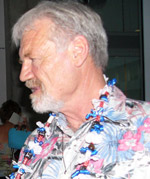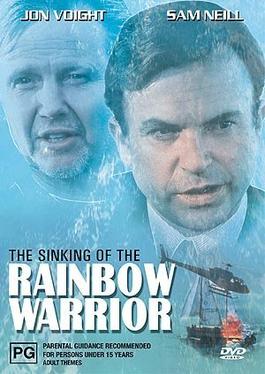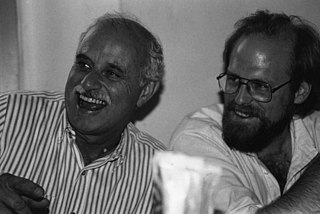Related Research Articles
Fernando Pereira was a Portuguese-Dutch freelance photographer, who drowned when French intelligence (DGSE) detonated a bomb and sank the Rainbow Warrior, owned by the environmental organisation Greenpeace on 10 July 1985.

The sinking of Rainbow Warrior, codenamed Opération Satanique, was a state terrorism bombing operation by the "action" branch of the French foreign intelligence agency, the Directorate-General for External Security (DGSE), carried out on 10 July 1985. During the operation, two operatives sank the flagship of the Greenpeace fleet, Rainbow Warrior, at the Port of Auckland on her way to a protest against a planned French nuclear test in Moruroa. Fernando Pereira, a photographer, drowned on the sinking ship.
Ouvéa, named after Ouvéa Island, was the name of a yacht used by three DGSE agents to import the naval mines used to sink the Greenpeace protest yacht Rainbow Warrior in 1985, killing photographer Fernando Pereira. The Ouvéa was sailed to Norfolk Island after the bombing. After New Zealand Police arrested two other agents still in New Zealand, the Ouvéa set to sea and was scuttled, while the crew transferred to the French submarine Rubis, to make their escape.

David Telfer Robie is a New Zealand author, journalist and media educator who has covered the Asia-Pacific region for international media for more than four decades. Robie is the author of several books on South Pacific media and politics and is an advocate for media freedom in the pacific region.

Eugène Charles Hernu was a French socialist politician. He served as Minister of Defence from 1981 to 1985, until forced to resign over the bombing of the Greenpeace ship Rainbow Warrior in New Zealand.
Peter Willcox is an American sea captain best known for his activism with the environmental organization Greenpeace. He was on board as captain of the Rainbow Warrior when it was bombed and sunk by the DGSE in New Zealand in 1985.
Alain Mafart is a French military officer best known for his part in the bombing of the Rainbow Warrior.
Gérard Royal is a former agent of the French intelligence agency Direction générale de la sécurité extérieure, who is accused of being one of those responsible for the bombing of the Greenpeace ship Rainbow Warrior. A long serving officer, who retired from the French Army with the rank of Colonel, Royal works in an "economic intelligence business". He is the brother of former French presidential candidate Ségolène Royal.
New Zealand has experienced few terrorist incidents in its short history and the threat is generally regarded as very low. However, the Security Intelligence Service (SIS) has warned against complacency. This article serves as a list and compilation of past acts of terrorism, attempts of terrorism, and other such items pertaining to terrorist activities within New Zealand. Significant acts of terrorism include the bombing of the Rainbow Warrior in 1985, an act of state-sponsored terrorism by France, and the Christchurch mosque shootings in 2019, a far-right attack which resulted in 51 deaths and 40 injuries.
In 1984, Prime Minister David Lange banned nuclear-powered or nuclear-armed ships from using New Zealand ports or entering New Zealand waters. Under the New Zealand Nuclear Free Zone, Disarmament, and Arms Control Act 1987, territorial sea, land and airspace of New Zealand became nuclear-free zones. This has since remained a part of New Zealand's foreign policy.

The Rainbow Warrior is a 1993 made-for-television drama film directed by Michael Tuchner and starring Jon Voight and Sam Neill.
The Rainbow Warrior Case was a dispute between New Zealand and France that arose in the aftermath of the sinking of the Rainbow Warrior. It was arbitrated by UN Secretary-General Javier Pérez de Cuéllar in 1986, and became significant in the subject of public international law for its implications on state responsibility.

France–New Zealand relations are the international relations between New Zealand and France. Relations between France and New Zealand have been rocky at times, but more recently have become much closer. Bilateral relations have been generally good since World War I and World War II, with both countries working closely during the conflicts, but the relationship was severely jeopardised by the sinking of the Rainbow Warrior in Auckland on 10 July 1985 by French Direction Générale de la Sécurité Extérieure (DGSE) agents.

Rainbow Warrior was a Greenpeace ship involved in campaigns against whaling, seal hunting, nuclear testing and nuclear waste dumping during the late 1970s and early 1980s. The Direction Générale de la Sécurité Extérieure bombed Rainbow Warrior in the Port of Auckland, New Zealand on 10 July 1985, sinking the ship and killing photographer Fernando Pereira.

Rainbow Warrior was a three-masted schooner most notable for service with the environmental protection organization Greenpeace. She was built to replace the original Rainbow Warrior that the French intelligence service (DGSE) bombed in 1985 in the Port of Auckland, New Zealand, which sank the ship and killed photographer Fernando Pereira.
Portuguese New Zealanders are either Portuguese who migrated to New Zealand, or New Zealanders of Portuguese descent. According to the latest 2018 New Zealand census, 447 residents of the country declared Portugal to be the place of their birth, and it is estimated that Portuguese migrants and their descendants number approximately 1,365, up from 900 in 2006, and 1000 in 1996.
Louis-Pierre Dillais is a French businessman. He acknowledged his involvement with the sinking of the Rainbow Warrior in an interview with New Zealand State broadcaster TVNZ in 2005. Admiral Pierre Lacoste said in 2005 to the New Zealand Herald that Dillais was not part of the "third team".
The Rainbow Warrior Conspiracy is a 1988 Australian-New Zealand mini series based on the Sinking of the Rainbow Warrior. It was written by David Phillips, and directed by Chris Thomson, and stars Jack Thompson, Brad Davis and Germain Houde.

Gillian Mary Hanly is a New Zealand artist. She is best known for documenting protests and social movements in New Zealand's recent history.

Stephen Gregory Sawyer was an American environmentalist and activist. He served as a leader of Greenpeace for nearly 30 years, including two decades as executive director. While on a mission to stop French nuclear testing in French Polynesia, he survived France's bombing of the Greenpeace boat Rainbow Warrior, which occurred on his 29th birthday.
References
- 1 2 Astier, Henri (8 July 2005). "French Expat Recalls NZ Bombing". BBC News. Retrieved 4 May 2016.
- ↑ Guisnel, Jean (7 July 1995). "Dominique Prieur. L'agente secrète refait surface et écrit. En 1985, la DGSE la charge de préparer l'attentat contre le "Rainbow Warrior". Dix ans plus tard, l'ancienne". Liberation (in French). Retrieved 4 May 2016.
- 1 2 "A beret, a bottle of Beaujolais and a baguette". Greenpeace International. Retrieved 8 May 2016.
- 1 2 3 Dejevsky, Mary (18 June 1995). "Attack on Boat Still Haunts Secret Agent". Independent. Retrieved 4 May 2016.
- 1 2 Trahair, Richard C. S.; Miller, Robert L., eds. (2009). Encyclopedia of Cold War Espionage, Spies, and Secret Operations (revised ed.). Enigma Books. p. 304. ISBN 9781929631759.
- ↑ "Saboteur spills the French beans". New Zealand Herald. 30 June 2000. ISSN 1170-0777 . Retrieved 8 May 2016.
- ↑ "The day Operation Satanic came to NZ". New Zealand Herald. 3 December 2002. ISSN 1170-0777 . Retrieved 8 May 2016.
- ↑ "Rainbow Warrior bombing". my.christchurchcitylibraries.com. Retrieved 8 May 2016.
- 1 2 3 O'Brien, Gregory (2007). News of the Swimmer Reaches Shore: A Guide to French Usage. Wellington, New Zealand: Victoria University Press. ISBN 978-0-86473-532-4.
- ↑ "Greenpeace Bombers". Logansport Pharos Tribume. 22 November 1985. Retrieved 4 May 2016– via Newspaper Archive.
- ↑ "Rainbow Warrior: 30th anniversary of bombing by French commandos in Auckland, New Zealand, on July 10, 1985". 10 July 2015. Retrieved 9 May 2016.
- ↑ "At the end of the Rainbow - National - NZ Herald News". Nzherald.co.nz. Retrieved 13 January 2014.
- 1 2 "France Ends Agent's Exile". Cedar Rapids Gazette. 7 May 1988. Retrieved 4 May 2016– via Newspaper Archive.
- ↑ "Spy: French Leader Ordered Sinking". Daily Herald Suburban Chicago. 11 July 2005. Retrieved 4 May 2016– via Newspaper Archive.
- 1 2 "Rainbow Warrior: Where Are They Now?". New Zealand Herald. 5 July 2016. Retrieved 4 May 2016.
- 1 2 "Ship Bombers Lose TV Appeal" . Gold Coast Bulletin. 27 September 2006. Retrieved 4 May 2016– via EBSCO.
- ↑ Staff (4 January 2009) "Fresh Start for Saboteur" Sunday Mail (South Australia) p. 29